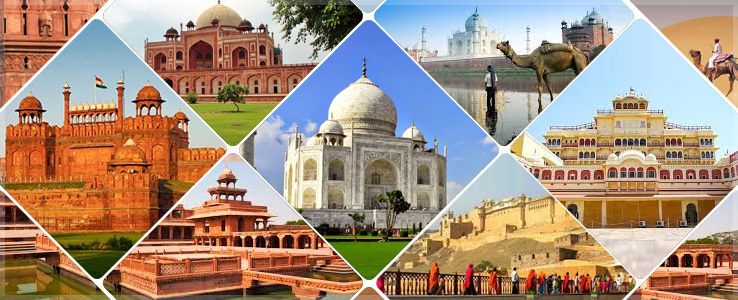India’s Golden Triangle Tour is a classic itinerary that connects three of the country’s most historically and culturally significant cities: Delhi, Agra, and Jaipur. This triangle-shaped route provides an authentic glimpse into India’s regal past, vibrant culture, architectural marvels, and urban evolution. Each city in the Golden Triangle offers unique experiences, making it ideal for history enthusiasts, architecture lovers, and cultural explorers. Below is a detailed overview of the top attractions in each city that you can explore during your journey.
Red Fort, Delhi
Built in 1648 by Mughal emperor Shah Jahan, the Red Fort in Old Delhi stands as a powerful symbol of India’s rich history and independence. The fort’s red sandstone walls enclose a complex of palaces, pavilions, and gardens. The Diwan-i-Aam (Hall of Public Audience) and Diwan-i-Khas (Hall of Private Audience) are notable structures showcasing Indo-Islamic architecture. This UNESCO World Heritage Site offers insights into Mughal governance and aesthetics. An evening sound and light show adds depth to the visitor experience, portraying the fort’s historical significance.
Humayun’s Tomb, Delhi
Humayun’s Tomb is one of the earliest examples of Mughal garden tombs and a precursor to the Taj Mahal in Agra. Built in the 16th century, this UNESCO World Heritage Site integrates Persian architectural influences with Indian craftsmanship. Surrounded by charbagh-style gardens, the tomb is not only the resting place of the Mughal emperor Humayun but also a peaceful escape from the city's bustle. It’s considered a masterpiece of Mughal design and symmetry.
Jama Masjid, Delhi
One of India’s largest mosques, Jama Masjid was commissioned by Shah Jahan in 1656. It can accommodate more than 25,000 worshippers at once and features red sandstone and white marble construction. Climbing the southern minaret offers panoramic views of Old Delhi, while the courtyard reflects the cultural diversity and religious coexistence of the region. The mosque remains an active place of worship and an essential stop for understanding the spiritual side of Delhi.
Taj Mahal, Agra
A universally recognized symbol of love, the Taj Mahal is a UNESCO World Heritage Site built by Emperor Shah Jahan in memory of his wife Mumtaz Mahal. Constructed entirely of white marble and adorned with intricate inlays, this 17th-century mausoleum changes hues with the day’s light. Its symmetrical design, reflecting pool, and Mughal garden layout make it one of the finest examples of Islamic architecture in the world. A Same Day Guided Tajmahal Tour with Agra Fort and Baby Taj offers a comprehensive look into Agra’s monumental heritage.
Agra Fort, Agra
Located just 2.5 kilometers from the Taj Mahal, Agra Fort is another UNESCO World Heritage Site showcasing Mughal military architecture. Originally built by Akbar and later modified by Shah Jahan, the fort houses structures like the Jahangiri Mahal, Diwan-i-Khas, and Musamman Burj—where Shah Jahan was held captive. Its red sandstone walls and palatial interiors reflect both strength and elegance, offering a deeper understanding of the empire’s administrative and domestic life.
Itmad-ud-Daulah’s Tomb (Baby Taj), Agra
Often referred to as the “Baby Taj,” this tomb was commissioned by Nur Jahan for her father, Mirza Ghiyas Beg, and is regarded as a draft of the Taj Mahal. Constructed with white marble and intricate pietra dura inlays, it’s the first Mughal tomb to be built entirely of marble. The tomb’s detailed craftsmanship, geometric gardens, and peaceful atmosphere make it a hidden gem that complements the grandeur of the Taj Mahal.
Amer Fort, Jaipur
Perched on a hilltop overlooking Maota Lake, Amer Fort (or Amber Fort) is a stunning blend of Hindu and Mughal architecture. Built in the late 16th century by Raja Man Singh I, the fort features ornate palaces, mirror work in Sheesh Mahal, and intricate frescoes in Ganesh Pol. Its defensive structure, artistic flourishes, and sprawling courtyards offer a comprehensive look into Rajput military and cultural life. The fort can be reached by jeep or on foot through scenic routes.
City Palace, Jaipur
The City Palace complex in Jaipur is a remarkable mix of Mughal and Rajasthani architectural styles. Located in the heart of the old city, it houses courtyards, museums, and royal residences. Key highlights include the Mubarak Mahal, Chandra Mahal, and Pritam Niwas Chowk with its iconic painted doorways. The palace offers a curated experience of Jaipur’s royal history and artistry, including artifacts, manuscripts, and royal garments. This palace is a vital part of most Rajasthan Tour Packages.
Hawa Mahal, Jaipur
Known as the “Palace of Winds,” Hawa Mahal is an iconic five-story pink sandstone structure with 953 jharokhas (small windows). Built in 1799 by Maharaja Sawai Pratap Singh, it allowed royal women to observe street festivals while remaining unseen. The honeycomb design facilitates natural cooling, a brilliant feature in Jaipur’s climate. It’s both a visual masterpiece and an innovative architectural marvel that represents the elegance of Rajasthani design.
Ranthambore National Park
While not a part of the Golden Triangle’s core, Ranthambore is a popular extension, especially for wildlife enthusiasts. Located near Jaipur, it’s one of India’s best-known tiger reserves. Jeep safaris allow visitors to explore its rugged terrain and spot Bengal tigers, leopards, sloth bears, and more. A Ranthambore Gypsy/Jeep Safari offers a chance to witness wildlife in their natural habitat while exploring ancient ruins and lakes within the park.
Conclusion
The Golden Triangle is more than just a tourist circuit—it’s a journey into India’s layered history, architectural evolution, and cultural depth. Each monument tells a story, each city offers a distinct flavor, and together they form an essential itinerary for anyone wishing to understand the soul of North India. By choosing a well-structured golden triangle india tour package, travelers can explore these timeless attractions with depth, context, and ease—ensuring an enriching travel experience grounded in heritage and authenticity.
